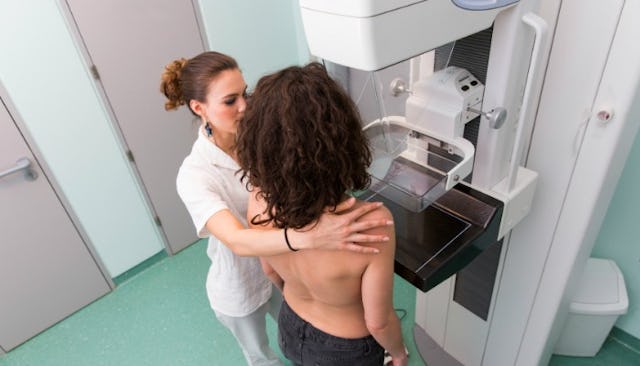Let’s Talk About That First Mammogram

Ladies, I hit 40 last year. You know what that means, yes? After my annual exam, I was sent off to make an appointment for my first mammogram. (You weren’t? More on that later.) Nothing says “celebrate” like an intimate new medical procedure, right? Happy birthday to me!
If you’re in the same boat, and you’re dreading it like a teenage girl dreading her first speculum, let me reassure you: It’s no big deal—five minutes, in and out; way better than the dentist; easier than a pap smear. I’ll put it this way: I’d rather get a mammogram than stand in line at the DMV.
But I didn’t know how easy it is before I got there. What I did know was that they told me to show up wearing no antiperspirant or deodorant. Of course, that was also the morning I’d agreed to be interviewed by a radio station about an article I’d written, so I nervous-sweated my way through that before driving my clammy self to the breast center. (For the record, I’d also rather get a mammogram than be interviewed on the radio. Recordings of me awkwardly answering spontaneous questions or photos of the insides of my boobs? No contest.)
Once I got my mini hospital gown on (“Opening in the front,” they said), a nurse brought me into the radiology room. In these days of smartphones that fit in our pockets, the mammography machine looks enormous. It’s tall and heavy-looking and takes up a ton of space, but the business portion—by which I mean the boob portion, obviously—is, oh, about the size of a George Foreman Grill.
You remember the George Foreman, right? That “Lean Mean Fat-Reducing Grilling Machine” from the 1990s? The one where you put the food on it and squish a lid down to cook it and squeeze out all the delicious fat? The concept’s pretty much the same for your mammogram, except the mammogram machine doesn’t cook your boob. The squishing, though, that totally happens. While you stand at the machine, the nurse artfully arranges your breast for maximum spreadage and squishage. (Men, I hope you’re not still reading. It ain’t pretty.) Then the nurse lowers the flat-top piece—the George Foreman lid, if you will—and it squeezes and clicks some X-rays. Same deal on the other side, of course.
Compression, yes. Pain? Nope.
Luckily, the nurse warned me that about half of first-time patients get a letter that asks them to schedule a follow-up. “Dense breasts,” they’ll tell you. In other words, our youthful 40-year-old breasts are so full and pert that it’s hard to see whether shadows and spots are suspicious in all that fabulous breast tissue. (I’ve apparently reached the age where I’ll take a compliment wherever I can marginally find one.)
Naturally, my breasts got a follow-up letter, and after more mammogram X-rays, which were even squeezier and thus not quite as comfy as the first, as well as a totally painless ultrasound, my suspicious spot was declared to be ordinary breast tissue. I am healthy!
Most of us get the all-clear after our mammograms. In fact, there’s recently been some confusion about whether or not we even need mammograms at our young age. An independent panel—the United States Preventive Services Task Force—recently said that mammograms for most women in their forties don’t reduce deaths from breast cancer, so we can safely skip them.
I don’t have any risk factors, like close family members with breast cancer, nor the presence of the BRCA gene mutation, so why did I bother?
For starters, the American Cancer Society and the American College of Obstetrics and Gynecology still favor mammograms for women in their forties. My midwife recommends mammograms starting at 40. (Yes, midwives care for non-pregnant women too.) My hospital, the Cleveland Clinic, one of the top hospitals in the country, also recommends annual mammograms starting at age 40. Invasive breast cancers still occur in 1 in 69 women in their forties, and most of these women do not have a family history of breast cancer. Besides, my health insurance fully covers routine annual mammograms starting at age 40.
I like my preventive care. I get regular dental X-rays to see how healthy my teeth are. I take my children and myself for annual physicals, and I get my cholesterol checked and routine blood work. I like knowing more and acting proactively to protect my health.
So count me in for a little inconvenience and a little squishing. While some now consider 40 to be “young” for a mammogram, I intend to keep myself (and my boobs) healthy for a good, long time. And what’s a bit of squishing when it comes to taking care of ourselves?
This article was originally published on